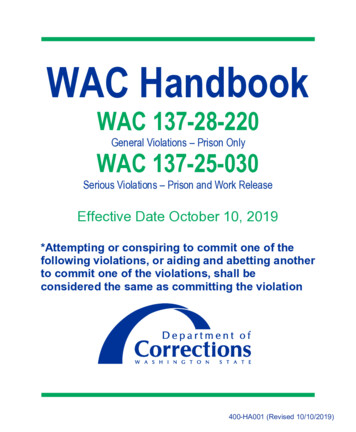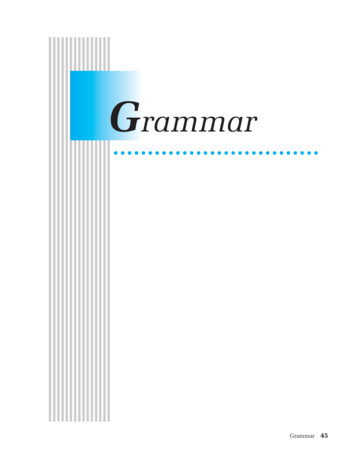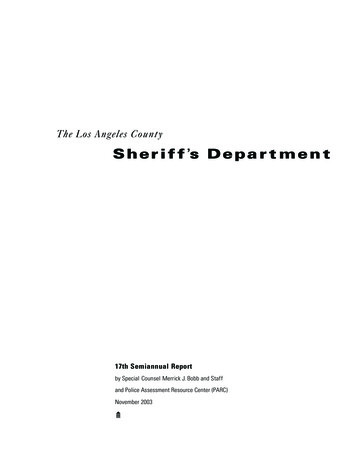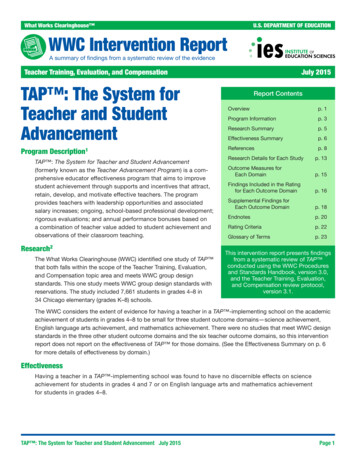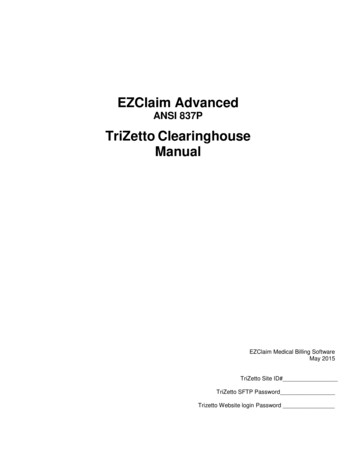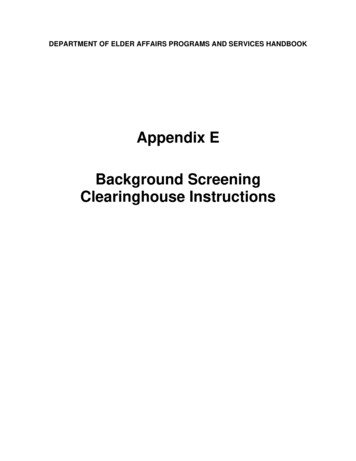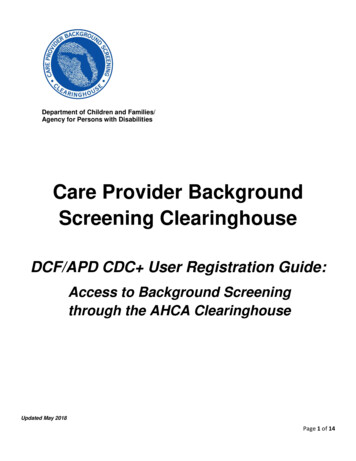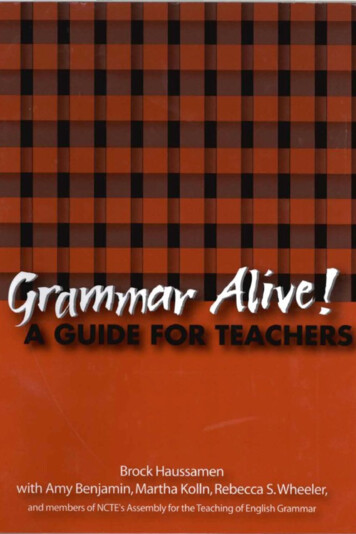
Transcription
Grammar Alivel
NCTE Editorial Board: Gwen Alexander, Elizabeth Close, Cora Lee Five, JoeJanangelo, Ray Levi, Shuaib Meacham, Jaime Armin Mejia, Carolyn Phipps,Kyoko Sato, Zarina Hock, Chair, ex officio, Kent Williamson, ex officioWe gratefully acknowledge the contributions of the following members ofthe NCTE Assembly for the Teaching of English Grammar:Paul E. DonigerHelene KrauthamerJohanna E. RubbaWanda Van GoorEdith WollinATEGThe NCTE Assembly for the Teaching of English Grammar aims to improvethe teaching of grammar at all levels, from elementary school through college;to promote communication and cooperation among teachers, researchers,administrators, and others interested in the teaching of grammar; to providean open forum in which advocates of all grammar theories, representing thebroad spectrum of views of grammar and its teaching, can interact. Throughits listserv, its conference, and its journal, Syntax in the Schools, ATEG offerseducators information about grammar and suggestions for better ways to teachit. (For more information, visit ATEG's Web site at www.ateg.org.)
Grammar Alive!A Guide for TeachersBrock Haussamenwith Amy Benjamin, Martha Kolln, Rebecca S. Wheeler,and members of NCTE's Assembly for the Teachingof English GrammarNational Council of Teachers of English1111 W. Kenyon Road, Urbana, Illinois 61801-1096
Chapter 5, "Non-Native Speakers in the English Classroom," was adapted fromthe book Differentiated Instruction: A Guide for Middle and High School by AmyBenjamin. This material is used with the permission of Eye on Education,Larchmont, New York, www.eyeoneducation.com.Staff Editor: Bonny GrahamInterior Design: Doug BurnettCover Design: Barbara Yale-ReadNCTE Stock Number: 18720-3050 2003 by the National Council of Teachers of English.All rights reserved. No part of this publication may be reproduced or trans mitted in any form or by any means, electronic or mechanical, including pho tocopy, or any information storage and retrieval system, without permissionfrom the copyright holder. Printed in the United States of America.It is the policy of NCTE in its journals and other publications to provide a fo rum for the open discussion of ideas concerning the con tent and the teachingof English and the language arts. Publicity accorded to any particular point ofview does not imply endorsement by the Executive Committee, the Board ofDirectors, or the membership at large, except in announcements of policy,where such endorsement is clearly specified.Although every attempt is made to ensure accuracy at the time of publication,NCTE cannot guarantee that all published addresses for electronic mail or Websites are current.Library of Congress Cataloging-in-Publication DataHaussamen, Brock.Grammar alive! : a guide for teachers I Brock Haussamen, with AmyBenjamin, Martha Kolin, and Rebecca Wheeler and members of NCTE'sAssembly for the Teaching of English Grammar.p.cm.Includes bibliographical references and index.ISBN 0-8141-1872-01. English language-Grammar-Study and teaching. 2. English language-Study and teaching. 3. Language arts. I. Assembly for the Teaching ofEnglish Grammar. II. Title.LB1576.H3235 2003372.61-dc222003015117
vContentsPrefaceviiVignette: Language about Language: A Middle School Grammar ClassIXIntroductionxiI. Grammar in the Classroom1. Three Goals for Teaching Grammar2. Discovering Grammar310Vignette: Flossie and the Fox: Code-Switching betweenthe Languages of Home and School14Vignette: Helping High School Juniors Get Comfortablewith Shakespeare's English203. Teaching the Language of Grammar23Vignette: Teaching the Passive Voice29Vignette: Teaching Pronouns with LEGOs31Vignette: Teaching the Absolute Phrase33Vignette: Subject-Verb Agreement: Slicing the Apple344. Flexing the Students' Sentence Sense37Vignette: Grammatical Choices, Sentence Boundaries,and Rhetorical Effects38Vignette: Sentence Imitation42Vignette: Teaching English Language Learners theKnown-New Pattern475. Non-Native Speakers in the English Classroom50Vignette: Teaching English Language Learners inElementary Grades61Vignette: Helping a Ninth-Grade Student Use the64
ContentsviII. On Grammar6. Grammar Superstitions: The Never-Never Rules717. Diagramming Sentences8. An Overview of Linguistic Grammar80Conclusion95A Grammar Glossary97Sources and Resources109Index113Author and Contributors119
viPrefaceThe Assembly for the Teaching of English Grammar (ATEG) wasborn in the late 1980s with Edward Vavra's newsletter Syntax inthe Schools, a forum for educators interested in the teaching ofgrammar and concerned about its neglect. The readers came togetherfor the first ATEG conference at Dr. Vavra's institution, ShenandoahCollege in Winchester, Virginia, in 1989. Martha Kolln, from Pennsyl vania State University, was elected president. In the years following,ATEG formally became an Assembly of the National Council of Teach ers of English. Its members hold an annual conference in July at differ ent institutions around the country. ATEG's goal has remained to en courage the effective teaching of grammar and to provide a forum fordiscussions about grammar teaching. The Assembly now publishes Syn tax in the Schools as a refereed journal and has a Web site at www.ateg.orgas well as an active listserv.This guide is the product of many years of ATEG members' ex citement about the possibilities for teaching grammar and their dismaythat the subject has remained so bogged down in outdated ideas andapproaches. In 1998, a committee began work on a report that evolvedinto this book.The several authors of the book have both written portions of itand helped revise one another's work, so the collaboration has been arich one. The introduction was written by Brock Haussamen, with re visions by Amy Benjamin. The three goals for the teaching of grammar,laid out in Chapter 1, were first formulated by Johanna Rubba; the dis cussions of the goals were written by Brock Haussamen. Most of thesuggestions for methods and lessons in Chapters 2, 3, and 4 were firstwritten by Amy Benjamin and Johanna Rubba. The methodology por tion of Chapter 2, "Discovering Grammar through Language Variety,"was written by Rebecca Wheeler. Chapter 5, "Non-Native Speakers inthe English Classroom," was adapted from the book Differentiated In struction: A Guide for Middle and High School by Amy Benjamin; it is usedwith the permission of the publisher, Eye on Education. I'm grateful toMiriam Moore and Christine Herron of Raritan Valley CommunityCollege for suggesting additions to this material. "Grammar Supersti tions: The Never-Never Rules," Chapter 6, was written by Amy Ben jamin. Chapter 7, "Diagramming Sentences," and the grammar glos sary were prepared by Brock Haussamen with help from Martha KolIn,
viiiPrefacebased on material from Understanding English Grammar by Martha KolInand Robert Funk. Chapter 8, "An Overview of Linguistic Grammar,"was written by Martha Kolln, who also contributed to the final edit ofthe whole manuscript. Chapters 3, 4, and the conclusion and portionsof other sections were written by Brock Haussamen, who also organizedand edited the entire book. The vignettes are signed by the authors.Additional ATEG members who commented on early drafts are PamDykstra, Loretta Gray, Edith Wollin, and Robert Yates. Finally, NCTESenior Editor Zarina Hock and several anonymous readers made manyhelpful suggestions about additions to the original manuscript as wellas improvements throughout the text.Brock HaussamenPresident, Assembly for the Teaching of English GrammarRaritan Valley Community College
VignetteVIGNETTE: LANGUAGE ABOUT LANGUAGE:A MIDDLE SCHOOL GRAMMAR CLASSThe voices of the seventh and eighth graders in Mrs. Cahill's period4 class spill out into the hall. Her students are often so boisterous thatshe feels a little chagrined: "What must people be thinking when theypass by this room sometimes during our Language Workshop?" shethinks.One thing few people would think is that Mrs. Cahill is teach ing grammar. There are no books, no exercises, no diagrams, no rulesand maxims to learn. What the students bring to the lesson is theirown language, the language they hear in their world. In today's les son, Mrs. Cahill will teach sentence completeness and the differencebetween formal and informal registers. She uses the language of streetsigns. The students call out the street signs they know, beginning withthe teacher's cues:No ParkingMerge LeftThe students burst into a torrent of street-sign language: Slip pery When Wet; Wrong Way; Go Back; Dead End; No Outlet; SurveyCrew Ahead; Last Exit Before Toll. Mrs. Cahill stops after writingtwenty sign messages on the board.Are any of these complete sentences?" she asks. "00 any haveboth a subject and a verb?" When the students agree that the streetsigns do not represent complete sentences, Mrs. Cahill asks this:"What if you were to put the words You should in front of these signs?Which ones would become complete sentences then?" The kids test"You should . " against the signs."You should merge left.""You should go back."This is the teachable moment about the understood you-sub ject of commands."What other street signs give commands?" The students add"Stop" and "Yield" to their list. Mrs. Cahill explains that in the En glish language we have a convention that makes commands soundless bossy. "How would you say 'Stop' or 'Yield' more politely?" Ofcourse, everyone says, "Please."" Are there any other ways to sound polite when making a com mand? How would you say the other signs politely?"IIix
VignettexThe kids respond with "Please do not park here" and "Pleaseturn around because you are going the wrong way."The teacher points out that although the "please" form is themost obvious, we also can sound polite (formalize our register) bysaying, "We would appreciate it if you would park elsewhere" or "Itmight be a good idea to merge left right about now." It's easy forkids to deduce that the formal register might not convey the neededimperative carried by the informal. When it comes to traffic signs,brevity is practical in more ways than one. "When you say it politely,it sounds like they don't have to do it right now," remarks one stu dent. "When you just say do it,' they obey the sign.""This is a dead end"; "This is the last exit before the tolL" Mrs.Cahill asks if these statements are polite or impolite. The kids see thatthey are neither. These iterations are neutral in tone. "How would youmake these signs dress down? How would you make them speak inan informal voice?""Wrong way, you idiot!""Wrong way . duh!""You better stop!""Hey, look at this view!"Mrs. Cahill asks the students to make columns for phrases andclauses and then for declarative sentences and commands.Mrs. Cahill's students think that her Language Workshop isfun, but they don't always see the connection between what they al ready know about language and what an English teacher cares about.So Mrs. Cahill prompts them. "What words have we used today thatgo in our Language About Language notes?" The students keep asection in their English notebook for terms such as tone, command,subject, verb, complete sentence, phrase, clause, formal, informal. Mrs.Cahill's Language Workshop has looked at advertising, slogans,movie quotations, sitcom titles, music, weather reports, dollar bills,CD jackets, and other examples of authentic language. The students'Language About Language pages continue to grow with examplesand new terminology. And they never use a grammar book!-Amy BenjaminI
x:IntroductionA Broken SubjectAt the start of this new millennium, throughout much of the K-12 En glish curriculum, grammar is a broken subject. If you find yourself justnot knowing what to do about grammar-how to teach it, how to ap ply it, how to learn what you yourself were never taught-you are notalone. Grammar is often ignored, broken off altogether from the teach ing of literature, rhetoric, drama, composition, and creative writing.Grammar is the skunk at the garden party of the language arts. Perhapsyou've set aside time for labeling parts of speech, correcting errors, andmodeling effective use of punctuation, but you may feel unmoored: youwonder whether the grammar you learned in school (what little theremay have been) is sufficient or if the methods you learned by are up to-date. And you certainly wouldn't be alone if you were embarrassedto reveal to your colleagues all that you don't know about grammar.Grammar feels like a frowning pedant reproaching you for not know ing enough about subject-verb agreement, for blithely ending sentenceswith prepositions, for splitting infinitives without even understandingwhat that means, for promiscuous use of commas and flagrant case vio lations. And, even if you speak and write with a confident tongue andwell-schooled hand, you may tremble at the thought of trying to get yourstudents to write complete sentences.You are not alone. The obstacles to revitalizing the teaching ofgrammar are several. One is that our profession has lost sight of theconnection between studying grammar and learning to read and write.As Robert J. Connors recounted in "The Erasure of the Sentence," ourinterest in analyzing sentences has faded since the 1970s. Today it is theprocess of writing, along with originality, authenticity, and personalwriting, that we value. The change has left sentence-level work-evensuch proven approaches as sentence combining-in shadow. We're notcomfortable encouraging students to be original and authentic oneminute and then assigning them exercises in sentence structure the next.Many English departments, and highly respected English teachers, ar gue forcefully that sentence-level work is mechanical, behavioristic,antihumanistic, and, most scorn-worthy of all, boring.Another obstacle to revitalizing the role of grammar is the ten sion between the traditional teaching of grammar and the varieties oflanguage that our students speak in their homes. It's understandable if
xuIntroductionyou feel on shaky ground at the thought of setting up rules about cor rect and incorrect English. After all, who are you to declare that yourbrand of English should trump anyone else's? One of the foremost goalsof the curriculum is to broaden the Western canon, fosteringmulticulturalism, not undermining it. How does living harmoniouslyin a pluralistic society square with the mandate to teach, model, andprefer the variety of English spoken easily by the dominant culture? Onthe other hand, we acknowledge our duty to equip students with thekeys they will need to open doors that might be closed to them on thebasis of their speech, not to mention their writing. English, like almostall languages, has a prestige dialect: the language of power is used forbusiness, education, and government. The opposing force is the valuethat we place on treasuring the diversity of American subcultures, andwhat is more intimate to these subcultures than their language? You maywell feel caught in the middle between these obligations, and there isno easy way to find a balance.These two tensions-between the traditional teaching of gram mar and the goals of both confident writing and the culturally inclu sive classroom--entail complex issues and valid charges. This guidefrom the Assembly for the Teaching of English Grammar does not ana lyze or deny the charges. Instead it is a proposal for overcoming bothconflicts by integrating grammar into the multicultural reading/writ ing classroom. It asks and proposes answers to several questions: How can we teach grammar to support learning in all languageskills? How can we teach grammar so that students discover its rulesand principles on their own instead of hearing us impose thoserules and principles on them? How can we teach grammar so that we strengthen rather thanundermine our efforts to honor the voices and cultures of allstudents? How can we teach grammar so that the knowledge it providescan help learners feel confident about their own language andappreciate the languages of others?We must answer these questions because, despite the rejection oftraditional grammar teaching, grammar does not go away. It appearsin almost all language arts texts. Almost all schoolchildren are assignedlessons on the parts of speech and the basic rules--even if they do notunderstand them, do not remember them, and cannot apply them. Wehave a nagging sense that we may not be delivering the full packagewhen we disregard grammar. But we don't know where to begin. You
Introductionare probably reading this book because you want to teach grammar orhave been required to do so. The education courses you took, however,probably neglected grammar and linguistics, so you may feel that youhave little choice but to follow the mostly dry, mechanical treatmentsof grammar, the "no-no's" of the rules and errors, that have changedlittle in the textbooks and are the reason so many believe that grammarshould instead be shelved.Two Kinds of GrammarThe underlying reason that grammar hangs on in the curriculum is thatwe realize that knowledge about language is valuable. Actually, the termgrammar refers to two kinds of knowledge about language. One is sub conscious knowledge, the language ability that children develop at anearly age without being taught. As children begin to talk, as they be come able to form sentences, their brains are forming their "grammarcircuits" automatically. The other kind of knowledge is the consciousunderstanding of sentences and texts that can help students improvetheir reading and writing abilities by building on that subconsciousknowledge. This conscious understanding includes knowing the partsof sentences and how they work together, knowing how sentences con nect with one another to build meaning, and understanding how andwhy we use language in different ways in different social situations.In teaching grammar in school, we are not really teaching gram mar at all: children learn that automatically; rather, we are teaching stu dents about grammar, and we are hoping to bring them the added con fidence and clarity that go with any knowledge that strengthens skillsand deepens understanding. That we are "teaching about grammar" isan insight that comes to us from work in linguistics over the last cen tury. This book includes some of that work.The problem with school grammar has not been grammar itselfas much as it has been the way grammar is usually taught. Instead ofhelping students to focus on real literature or on the actual paper theyare writing, traditional grammar pedagogy requires students to diverttheir attention to the isolated and often contrived sentences in a text book. It encourages students-and teachers-to believe that the author ity for Standard English is that separate book of rules rather than lit erature and the language of those with power and prestige in the liv ing culture. It focuses on errors instead of on the understanding of lan guage. Some teachers still lament that they can teach comma rules orsubject-verb agreement at length only to find that their students con tinue to make the errors. But many other teachers do understand thatxiii
xivIntroductionwriting is an exceedingly complex cognitive and social task. The reduc tion of conventional errors takes a great deal of experience in reading,in writing, and in talking about reading and writing. Formal grammaris a tool for talking about and thinking about sentences; it is not, by it self, a tool for making errors go away (as Constance Weaver emphasizesin Teaching Grarnrnar in Context and in her other books, listed in the"Sources and Resources" section at the end of the book).Let's consider the traditions that stand behind the way formalgrammar has been taught out of the textbook. We do this to understandhow grammar education has become what it is today. Until the mod em era, the teaching of grammar rules was primarily a method for teach ing a foreign language. The emphases on the parts of speech, the dissec tion of sentences, and the correct answers to exercises all have ancientand medieval roots in grammar as a method for teaching a second lan (Brock Haussamen has traced the history of many of our tradi tional grammar rules and terms in Revising the Rules: Traditional Gram mar and Modern Linguistics; see "Sources and Resources.") Grammarbooks were first used to teach Homeric Greek to non-Greeks, then Latinto non-Romans. Then, in eighteenth-century England, educators whobelieved that they needed to correct the"flawed" language of working class children and adults adopted the same classical tools and models(they fussed, for example, that perhaps sentences should not end withprepositions because they never did so in Latin), and we have been usingthe same approaches ever since.The result has been that we have traditionally taught grammarto students without appreciating the fact that they already have a fullgrammar system-an ability to organize language meaningfully-intheir heads. Consequently, the grammar of the classroom has oftenseemed to students like so much unnecessary jargon they have to learnabout a language they already know. Or, if students are dialect speak ers for whom mainstream English is puzzling and strange, traditionalgrammar, with all its rules and exceptions (do you remember all theexceptions to the subject-verb agreement rule?), is not much help. To day, we know more about language, we know more about how brainslearn, and we need to reorient ourselves about grammar.The time may be propitious for a new approach to grammar be cause attitudes toward traditional grammar and mechanical correctnesshave been shifting in recent decades. The English profession in generaland the National Council of Teachers of English in particular began toreduce the emphasis on the traditional teaching of grammar in the 1960sand 1970s as research began to show that teaching grammar in isola
Introductiontion failed to improve writing and only cut into time better spent onfluency, process, and voice. In the 1990s, pockets of revitalized and genu inely useful grammar appeared in books-the most popular ones byConstance Weaver, Martha Kolln, and Rei Noguchi-that integrated lin guistic grammar and traditional grammar and showed teachers waysto apply this modernized grammar in the classroom. But a new trendlooms. High-stakes testing threatens to bring back grammar in its mostreactionary and ineffective form-the monotonous drilling on errors andparts of speech. We can only hope that standardized testing promptsall English educators to take a closer look at the new insights into theteaching of grammar if for no other reason than to avoid taking a giantstep backwards.Grammar Alive! consists of two parts. Part I focuses primarily onstrategies for teaching grammar. Part 11 focuses more on grammar it self and information about grammar that you might find useful.Part I opens with "Three Goals for Teaching Grammar," goals withequal priority that enable grammar to take on a balanced and positiverole in the language arts classroom. Chapter 2, "Discovering Grammar,"discusses such terms as Standard English and offers approaches for in troducing students to the presence of grammar in the full range of spo ken and written language. Chapter 3, "Teaching the Language of Gram mar," discusses new approaches to describing the parts of speech andto helping students understand and apply them. Chapter 4, "Flexingthe Students' Sentence Sense," focuses on how much students alreadyknow about sentences and how they can apply that knowledge to im prove their writing and their appreciation of literature. Chapter 5 is"Non-Native Speakers in the English Classroom"; this section discussessome of the differences between English and the other languages thatstudents may be speaking, and it covers many suggestions for helpingsuch students in the English classroom. Vignettes-narrations of class room grammar lessons-are integrated into or follow each of these chap ters.Part II, "On Grammar," covers information about grammar thatcan clarify your own understanding of the subject and give you furtheroptions in the classroom. Chapter 6, "Grammar Superstitions: TheNever-Never Rules," discusses such supposed errors as the split infini tive that you may not be sure about. Chapter 7, "Diagramming Sen tences," provides a short guide to traditional sentence diagrams. Chap ter 8, "An Overview of Linguistic Grammar," is a full introduction tothe current linguistic descriptions of word classes and sentence struc ture.xv
xviIntroductionIn the conclusion, you will find a grammar glossary that will helpyou refresh your understanding of exactly what all the grammar termsmean, and it includes plenty of examples. An annotated list of sourcesand resources in print and on the Internet will help you find furtherinformation about the teaching of grammar.
I Grammar in theClassroom
31 Three Goals for TeachingGrammarhe three goals presented in this chapter are intended-in wordsborrowed from the introduction to the NCTE/IRA Standards forthe English Language Arts-to "embody a coherent, professionallydefensible conception of how a field can be framed for purposes of in struction" (viii). They state outcomes in grammar instruction that in clude a wide range of abilities related to grammar, from the ability towrite Standard English to an understanding of language prejudice.You may find them ambitious and idealistic, and they are. Thesegoals are intended to provide direction and context for grammar in struction up through the completion of high school. You may haveasked yourself what you can possibly teach your students about a com plex subject like grammar during the year they will be in your class.You may not know what grammar, if any, your students have beentaught or will be taught by other teachers. When we as teachers are notsure whether grammar is included throughout our curriculum, we tendto stick to the basics-the basic writing errors, the basic parts of speech.For students, the result is often tedious repetition. In such a discon nected grammar curriculum, students lose out on much of grammarthat is important and exciting.In contrast, these three grammar goals summarize three strandsof a comprehensive grammar curriculum. In a language arts curricu lum that included these strands, students would not only develop acommand of Standard English, but they would also understand at abasic level the role that language structure plays in literature, the waylanguage changes through time and in different social situations, andthe fact that all languages and language varieties have grammaticalstructure. Ambitious? Certainly. But the following chapters will eachdiscuss ways that you and your students can work toward theseachievements.TAbout the Three Grammar GoalsGoal AEvery student, from every background, will complete school withthe ability to communicate comfortably and effectively in both
Chapter 14Goals for Teaching GrammarCoal AEvery student, from every background, will complete school with theability to communicate comfortably and effectively in both spokenand written Standard English, with awareness of when use of Stan dard English is appropriate.Coal BEvery student will complete school with the ability to analyze thegrammatical structure of sentences within English texts, using gram matical terminology correctly and demonstrating knowledge of howsentence-level grammatical structure contributes to the coherence ofparagraphs and texts.CoaleEvery student will complete school with an understanding of, andappreciation for, the natural variation that occurs in language acrosstime, social situation, and social group. While recognizing the needfor mastering Standard English, students will also demonstrate an un derstanding of the equality in the expressive capacity and linguisticstructure among a range of language varieties both vernacular andstandard, as well as an understanding of language-based prejudice.spoken and written Standard English, with awareness of whenuse of Standard English is appropriate."Standard English" is the variety of English that many people in theeconomic mainstream and predominant social culture of the UnitedStates speak and write. Sometimes it is called Mainstream AmericanEnglish. Standard English is the variety of English that grammar booksdescribe. It is standard not in the sense that it is better English than othervarieties but in the sense that it is the widely recognized and codifiedversion of English.A more precise name for it is Edited American English-"Edited"since it is the version of our language that writers and editors of booksand periodicals follow, and" American" in that it is the language writ ten in the United States as opposed to England, where some spellings(color colour; airplane, aeroplane), vocabulary (mailbox, pillar box; gasoline,petrol)1 and usage (e.g., the deletion of the definite article, as in She is inhospital) are different.l
Three Goals for Teaching GrammarStandard English is sometimes referred to also as the Languageof Wider Communication, a name reflecting the belief that when peoplein the United States talk or write to people other than friends and fam ily in another part of the country, this is the language that is most likelyto be the common currency." It is the language variety that the strangerin an office at the other end of the telephone or letter or e-mail will prob ably be the most familiar with.But the notion of a standard language raises some questions thatare obvious if you think about the word for a moment. Standard forwhom? Everywhere? Always? In all details? Standard English is not asingle, pure type of English, although some people like to think that itis so specific and so solid, like a yardstick made of gold, that we cancompare it with samples of language and find out easily whether thesamples fall short.For instance, there i
the English Classroom," was adapted from the book . . based on material from Understanding English Grammar by Martha KolIn and Robert Funk. Chapter 8, "An Overview of Linguistic Grammar," was written by Martha Kolln, who also contributed to the final edit of the whole m

